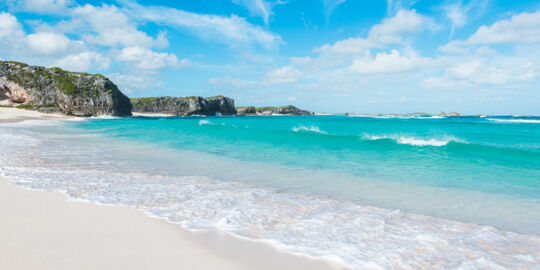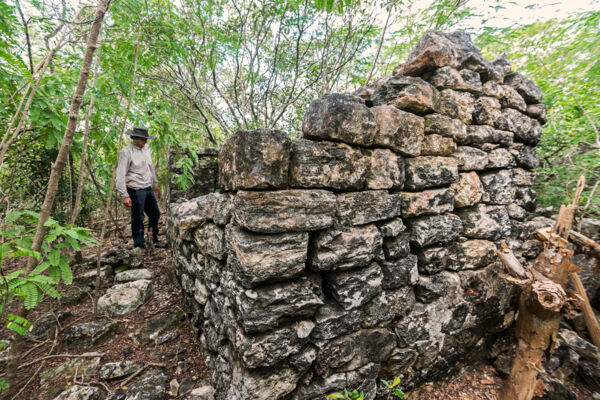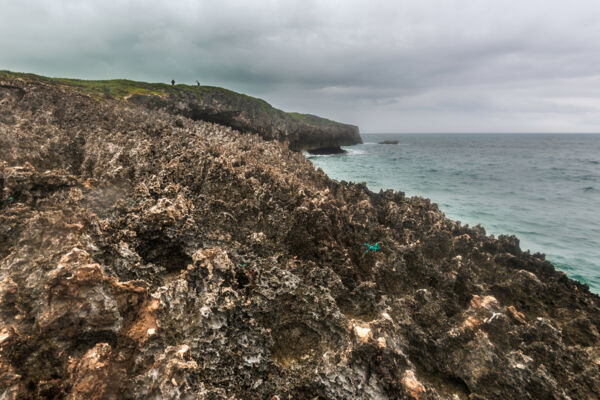North Caicos & Middle Caicos Sights & Attractions














Tropical Wilderness Awaits!
More so than the other islands in the country, North Caicos and Middle Caicos have quite a few non-beach natural attractions, including caves, sea cliffs, plantation ruins, and more.
Wild and Spectacular Coastlines
Of all the islands in the Turks and Caicos, Middle Caicos definitely takes the lead in majestic coastlines.
Mudjin Harbour is justly a contender for best landscape in the Turks and Caicos. High limestone cliffs, hidden beaches, and the rugged Dragon Cay create an unmatched day trip destination. When there’s a high ocean swell, the grand and rolling waves here are incredible and can be watched for hours.
The Crossing Place Trail continues to the west atop the Mudjin Harbour cliffs and offers countless spectacular views and hidden beaches. This environment hides amazing limestone terrains, including dry cave features that have been altered and overprinted by the ocean, intricate and treacherous limestone ironshore features, and a tenacious and salt-resistant collection of plant life.
Other amazing coastal sites include the turquoise Bottle Creek Lagoon, the cliffs and coves of Haulover Point, and the incredible shallow water and sandbars of Cedar Point.
Caves and Blue Holes
Formed slowly over time by the Karst system of dissolution, sinkholes, caves, and blue holes abound on North Caicos and Middle Caicos.
The elaborate Conch Bar Caves is the best-known system in the country. Used as a storm shelter by the Taino aborigines and later on mined for guano during the plantation days, this is the largest dry cave in the entire Turks and Caicos–Bahamas archipelago.
Indian Cave is another fascinating sight. This feature is a large open gallery cave, with sinkhole skylights, wild ficus trees and papayas.
Cottage Pond is a great example of a tropical blue hole. Bottoming out at about 260 feet (80 m), this round brackish pond hides submerged cave systems as well.
Rarely visited due to the difficulty of access, the Middle Caicos Ocean Hole is unbelievably huge. Evidence suggests that this perfectly-circular feature is quite likely the widest blue hole in the world.
Juniper Hole is one of the largest sea caves in the Turks and Caicos, and is one of the many sights on the Crossing Place Trail.
The Loyalist Plantations
Both islands also have had a long history with planting and agriculture, once supporting a lucrative cotton industry and dozens of expansive plantations.
Today, the ruined late-1700s plantations of Wade’s Green and Haulover are open to the public, but many other sites remain abandoned and lost in the dense vegetation.
During their heyday, these plantations had the reputation for raising some of the finest cotton in the Americas. The common strain grown was referred to at the time as Sea Island Cotton, and was actually introduced to our archipelago by the indigenous Taino peoples.
Birdwatching
Birdwatching is another great attraction of North and Middle Caicos. Both islands feature extensive wetland systems, with tidal mangrove shallows, brackish ponds, and landlocked interior saline flats.
The distinct ecosystems across the islands attract differing birds. The marine ponds support flamingos, tricolored herons, great blue herons, green herons, reddish egrets, great egrets, and cormorants.
On the coasts, ospreys, pelicans, stilts, long-tailed tropic birds, and terns can be seen. Although not a globally rare species, the fascinating common barn owl is a great sight and makes its home in the caves and ruins on the islands.
The freshwater sites, such as Cottage Pond, shelter ducks and grebes, and the high canopy of the tropical dry forests of Kew and Wade’s Green are alive with warblers, blue-gray gnatcatchers, bananaquits, and Bahamas woodstar hummingbirds.
One positive aspect of birding on North and Middle Caicos is that there’s always another site visit. Flamingo Pond Overlook is a good place to start, yet the back roads of the two islands lead past countless ponds and waterways. Interesting sites include the Pumpkin Bluff ponds, the inland ponds at the Crossing Place Trail, and the salt flats near Haulover Plantation and Haulover Point.
The Turks and Caicos is home to an impressive number of birds, plants, and reptiles that are endangered or are found nowhere else.
The Caicos Pine, a variety of the Caribbean Pine, is one such example. This tree is a true pine (unlike the invasive casuarina that thrives on many of our coastlines) and is only found on a few islands in the center of the country. The Caicos Pine Yard Trail attraction is a great place to see and learn about this endangered tree.
The West Indian whistling duck, which can be seen at times in our waterways, is another example at risk due to its wetland habitat being on decline in the Caribbean.







